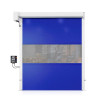Productivity: Quick door that is automatically repaired
Thinking about security and increased productivity in the industry, we developed a fast door that is automatically repaired: the door fast self-reparable FIX.
Developed for intensive use, this door integrates a system that is self-repaired when the canvas moves from the guides. This is possible thanks to the developed and tested profiles, so that it always works with maximum security.
How does the system work?
When the canvas suffers an impact and jumps out, the self-reparation system on the rise forces the canvas to return to the site.
This function avoids the need for a specialized technician to repair the door and thus saves time and money.
What are the differences in construction regarding conventional doors?
It has an opening for the reentry of the canvas
The side guides have openings so that, when opening the door, the canvas can enter back into the guides, placing it in the right position and ready to close.

The zip closure system eliminates the need for horizontal crossbars
Through a zip closure system applied on the sides of the canvas, the use of crossbars is no longer necessary.
These automatic fast doors, as is the case of FIX, can be installed in the most diverse industrial sectors, such as: in food distribution centers, in the railway sector, in construction, among others.

Other features of Quick Door FIX Self-repair
- Suitable for high air pressure zones.
- 750 W power triphase engine, for intensive use
- Central with hermetic industrial box and up, down and stop button
- MF2020 column photocells that protect people and merchandise
- External pulser
Do you think the time has come to invest in the automation of your business?
According to some specialized studies, such as those of the MicKinsey Global Institute, the impact of automation in the coming decades will be two or three times greater and, in order to achieve the best results, people and technology should work as a team.
Share this content

